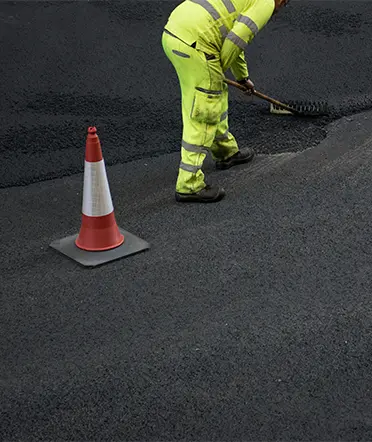Hot asphalt is applied at temperatures between 275°F and 350°F. Even brief contact can cause severe thermal burns or chemical irritation. Anyone working around paving materials — from contractors to maintenance crews — should know how to respond immediately if an asphalt burn occurs.
What Causes Asphalt Burns
Asphalt burns are usually caused by:
- Direct skin contact with hot mix asphalt (HMA)
- Splashes during pouring or spreading
- Equipment malfunctions or leaks from sealant machines
- Inadequate or damaged protective gear
Hot asphalt adheres to the skin, so quick and correct first aid is critical to prevent deeper injury.
Immediate Steps to Handle an Asphalt Burn
1. Move away from the heat source.
Get the affected person away from hot material or equipment. Do not try to remove asphalt while it is still hot.
2. Cool the area.
Run cool (not cold) clean water over the burn for 10–20 minutes. This stops the burning process and helps asphalt harden for safer removal. Avoid ice or ointments.
3. Do not peel or force-remove asphalt.
Let it cool and harden naturally. Forcing removal can worsen the injury.
4. Cover the burn loosely.
Use a sterile, non-stick dressing or clean cloth to prevent infection.
5. Seek medical attention immediately.
Hot asphalt can cause second- or third-degree burns. Medical evaluation is essential, especially if the burn is large or affects sensitive areas.
Medical Treatment for Asphalt Burns
Professional treatment includes:
- Careful removal using mineral oil or petroleum jelly
- Cleaning and debridement to prevent infection
- Topical antibiotics and pain relief medication
- Tetanus vaccination if required
Documenting workplace burns is recommended for safety compliance.
Preventing Asphalt Burns
Wear Proper PPE:
Always use heat-resistant gloves, boots, long sleeves, face shields, and high-visibility clothing.
Train All Crew Members:
Every team member should understand asphalt handling procedures, first aid basics, and equipment safety.
Inspect Equipment Regularly:
Check hoses, pumps, and mixers before use to prevent leaks or pressure bursts.
Establish Safe Work Zones:
Use barriers, signage, and keep first aid kits and cool water sources easily accessible.
Plan for Heat Conditions:
In hot weather, schedule work strategically and provide shade, hydration, and rest periods to reduce risk.
Aftercare and Reporting
Following treatment, record the incident, identify what caused it, and update safety protocols. Conduct refresher training to prevent recurrence. Consistent reporting and analysis strengthen on-site safety culture.
Final Thoughts
Asphalt burns can happen in seconds but have long-term consequences if mishandled. Prompt first aid, professional medical care, and consistent safety practices are essential. At AMR New York, we emphasize safety as a foundation for quality asphalt paving and maintenance.
For expert asphalt paving, sealcoating, or repair services in New York, contact AMR New York for a consultation today.
Additional Reads:
Your Guide to Sealcoating Safety: Top 6 Seal Coating Tips
